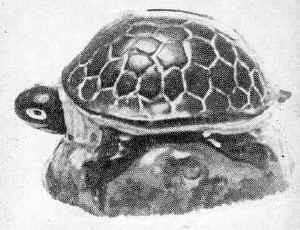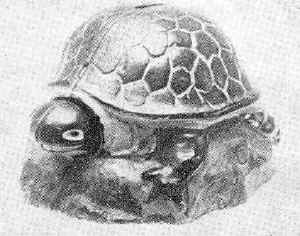A Turtle Bank
by F.H. Griffith - HOBBIES Magazine - July, 1970
 There may well be some interesting things happening during the
remainder of 1970 with respect to mechanical banks, but certainly it will be difficult to
top the month of May. A Turtle Bank, the last one turned up around 30 years ago, was found
in Iowa and went with reasonable promptness into one of the larger collections.
There may well be some interesting things happening during the
remainder of 1970 with respect to mechanical banks, but certainly it will be difficult to
top the month of May. A Turtle Bank, the last one turned up around 30 years ago, was found
in Iowa and went with reasonable promptness into one of the larger collections.
The Turtle is a bank that has one of those "things" about it. It is very rare, no great action, but an extremely desirable item. Its entire background is intriguing since the other three companion banks, The Frog On Rock, Owl, and Rabbit In Cabbage, are quite common. These three were made in large quantities by Kilgore Manufacturing Company, but the Turtle was a very limited production bank. The writer was never able to find out just how many were made, only that it was produced in small quantity. Actually at the time the writer was checking this out with the Kilgore officials, early 1940’s, they had no record of the exact number of Turtles they had manufactured.
The present Turtle, the fourth one known to exist, was found by Joe Olimpio, whose wife has the Alladin Antiques in Sanbornville, N.H. Joe purchased the bank from Mr. & Mrs. Jack Martens of Sheldon, Ia. They in turn had obtained the bank in an estate sale some 10 years ago and subsequently realizing it had some value kept it in a safe deposit box until the time it passed on into Mr. Olimpio’s possession. The bank was first put up for offers, Joe feeling this was the fairest way to dispose of it, and a few days ago at the time of this writing the Turtle found a permanent home in the collection of Leon Perelman. The situation wound itself down to being between two collectors, Lee being one of them. He now joins a select group of those possessing a Turtle Bank. The others are: The Hegarty Turtle from the late Dr. Arthur E. Corby collection; the Tudor Turtle from the Lederer collection and prior to this the late James C. Jones; the Griffith Turtle from the late Leon Cameto collection and prior to this the late William F. Ferguson. These three Turtles are in fine mint condition, completely original, and all alike in every detail.
 Now we come to an interesting point. The Perelman Turtle pictured
is also in fine original mint condition, however, it is a variety. It does not have the
protective plate covering the working mechanism inside the bank. It was made this way and
undoubtedly Kilgore found that coins could interfere with the mechanism and operation of
the bank and thus added the protective cast iron cover plate. On the three Turtle Banks
that are alike there is a hole on each side of the shell and a hole under the head. The
cover plate fits inside into these holes to hold it in place. The bank under discussion
does not have the holes on each side of the shell — it does have a slot hole under
the head and one over the head into which the mechanism fits.
Now we come to an interesting point. The Perelman Turtle pictured
is also in fine original mint condition, however, it is a variety. It does not have the
protective plate covering the working mechanism inside the bank. It was made this way and
undoubtedly Kilgore found that coins could interfere with the mechanism and operation of
the bank and thus added the protective cast iron cover plate. On the three Turtle Banks
that are alike there is a hole on each side of the shell and a hole under the head. The
cover plate fits inside into these holes to hold it in place. The bank under discussion
does not have the holes on each side of the shell — it does have a slot hole under
the head and one over the head into which the mechanism fits.
There are two other visible slight differences (the writer uses "visible" since, while he is sure the four banks have the same operating mechanism, it cannot be seen in three of them as it is covered by the plate). The pin or rivet holding the pictured bank together is peened over on both ends, although like the other three it would seem to have threads in one end screwed into the right half. The paint is slightly different on the one shown. The head of the Turtle does not have the five white stripes on top as do the other three. Also the base has more brown color to it than green, and there are orange markings on the blue on each side of the head.
The fact this Turtle is a variety is of considerable interest. It compares with the Kilgore Owl Bank. This comes in two types, rather than varieties, one with a slot in the head and the more common type with the slot in the book. Undoubtedly Kilgore made this change for the same reason, coins were more apt to interfere with the operating mechanism in one than the other.
In closing, Mr. Perelman is to be congratulated on his acquisition of the rare Turtle Bank. It has always been and will always be one of the writer’s favorite banks in his own collection.
